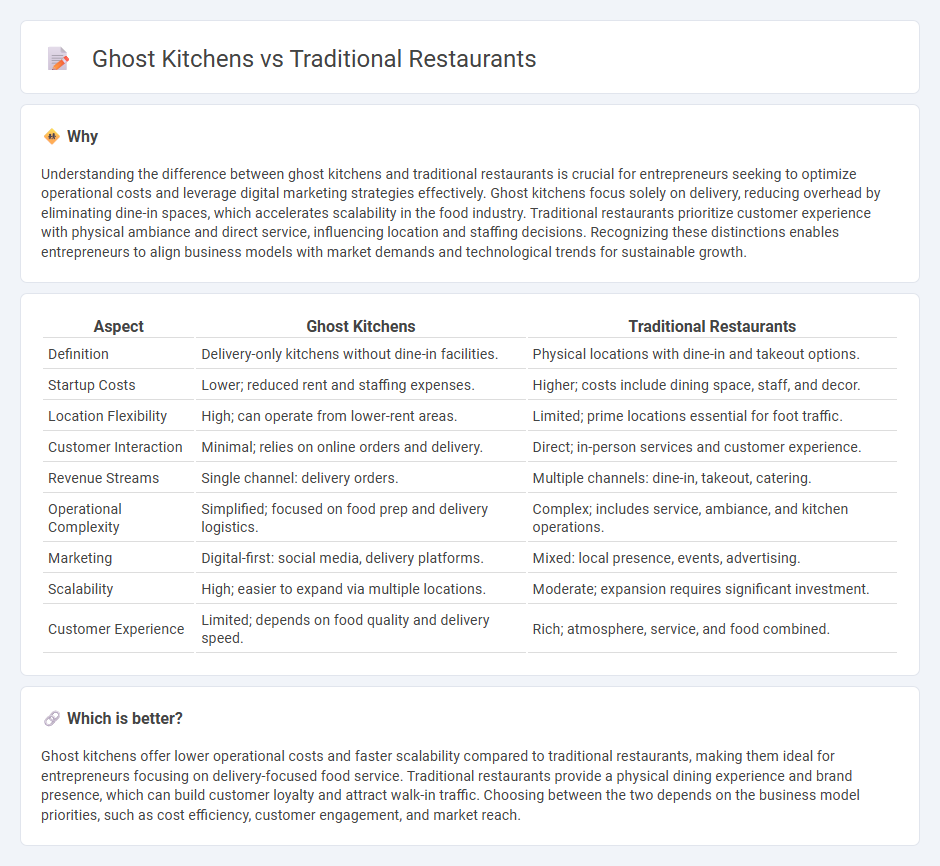
Ghost kitchens operate solely as delivery-only food preparation facilities, leveraging digital ordering platforms and lower overhead costs compared to traditional restaurants. Traditional restaurants offer dine-in experiences with higher operational expenses and extensive customer service infrastructure. Explore the evolving dynamics between ghost kitchens and traditional restaurants to understand the future of food entrepreneurship.
Why it is important
Understanding the difference between ghost kitchens and traditional restaurants is crucial for entrepreneurs seeking to optimize operational costs and leverage digital marketing strategies effectively. Ghost kitchens focus solely on delivery, reducing overhead by eliminating dine-in spaces, which accelerates scalability in the food industry. Traditional restaurants prioritize customer experience with physical ambiance and direct service, influencing location and staffing decisions. Recognizing these distinctions enables entrepreneurs to align business models with market demands and technological trends for sustainable growth.
Comparison Table
| Aspect | Ghost Kitchens | Traditional Restaurants |
|---|---|---|
| Definition | Delivery-only kitchens without dine-in facilities. | Physical locations with dine-in and takeout options. |
| Startup Costs | Lower; reduced rent and staffing expenses. | Higher; costs include dining space, staff, and decor. |
| Location Flexibility | High; can operate from lower-rent areas. | Limited; prime locations essential for foot traffic. |
| Customer Interaction | Minimal; relies on online orders and delivery. | Direct; in-person services and customer experience. |
| Revenue Streams | Single channel: delivery orders. | Multiple channels: dine-in, takeout, catering. |
| Operational Complexity | Simplified; focused on food prep and delivery logistics. | Complex; includes service, ambiance, and kitchen operations. |
| Marketing | Digital-first: social media, delivery platforms. | Mixed: local presence, events, advertising. |
| Scalability | High; easier to expand via multiple locations. | Moderate; expansion requires significant investment. |
| Customer Experience | Limited; depends on food quality and delivery speed. | Rich; atmosphere, service, and food combined. |
Which is better?
Ghost kitchens offer lower operational costs and faster scalability compared to traditional restaurants, making them ideal for entrepreneurs focusing on delivery-focused food service. Traditional restaurants provide a physical dining experience and brand presence, which can build customer loyalty and attract walk-in traffic. Choosing between the two depends on the business model priorities, such as cost efficiency, customer engagement, and market reach.
Connection
Ghost kitchens and traditional restaurants intersect through shared culinary expertise, operational efficiencies, and market demand insights. Both leverage digital ordering platforms and data analytics to optimize menu offerings and customer reach, enhancing profitability. This connection enables traditional restaurants to expand delivery services without physical expansion, while ghost kitchens benefit from established brand recognition and culinary innovation.
Key Terms
Brick-and-Mortar Location
Brick-and-mortar locations offer traditional restaurants a tangible presence that enhances customer experience through ambiance, immediate service, and in-person interaction. Ghost kitchens operate without physical dining spaces, significantly reducing overhead costs while focusing solely on food delivery and takeout efficiency. Explore how the location strategy impacts operational dynamics and customer preferences in the evolving foodservice industry.
Delivery-Only Model
Ghost kitchens operate solely through delivery services, minimizing overhead costs by eliminating the need for a physical dining space, unlike traditional restaurants that cater to both dine-in and takeout customers. This delivery-only model leverages technology and third-party apps for order management and food delivery, optimizing operations and expanding market reach. Discover how this shift to ghost kitchens is transforming the food industry and influencing consumer behavior.
Overhead Costs
Traditional restaurants incur significant overhead costs including rent, utilities, and in-house staff salaries, which can account for up to 60% of total expenses. Ghost kitchens, on the other hand, operate with minimal physical space and reduced labor, lowering overhead costs by approximately 30-50%. Explore detailed cost comparisons and operational efficiencies to understand which model suits your business goals.
Source and External Links
150 Most Legendary Restaurants in the World & Their Iconic Dishes - A curated list of enduring traditional restaurants worldwide, like Paragon in India famous for Biryani and Trattoria Vecchia Roma in Italy known for Amatriciana, showcasing authentic, time-honored local cuisines and atmospheres.
Most Classic Restaurants | New Orleans - Highlights New Orleans' classic dining institutions such as Antoine's (oldest family-run restaurant), Commander's Palace, and Lil' Dizzy's, which serve traditional Creole and Southern dishes in historic and welcoming settings.
23 Classic Restaurants In Houston - Features longstanding Houston eateries like Irma's Original with Tex-Mex daily specials and Burns in Acres Homes with traditional East Texas-style barbecue, embodying the region's culinary heritage through genuine flavors and hospitable environments.
 dowidth.com
dowidth.com